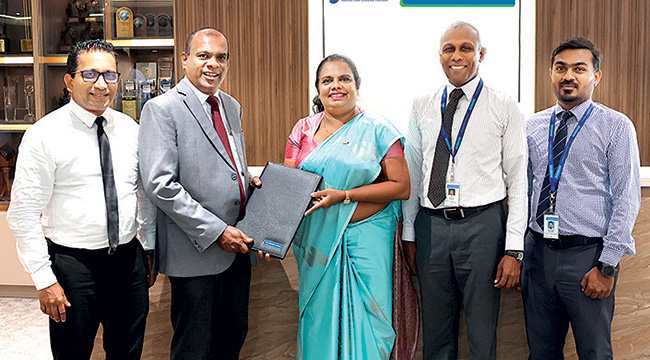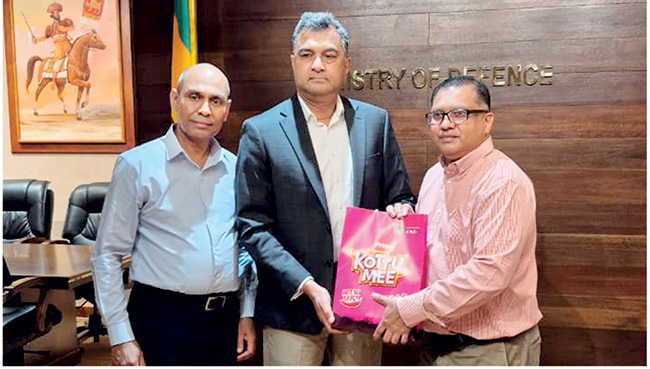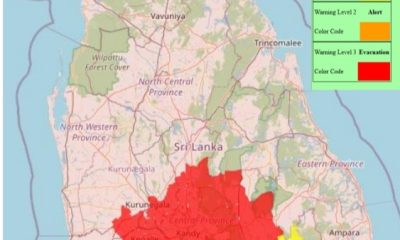Business
Exploring the goodness of Sri Lankan natural sea salt and lagoon salt

By Dr Ajith Shanmuganathan
Salt has played a significant role throughout human history, enhancing the flavour of countless dishes. In recent times, natural sea salt and lagoon salt have gained popularity due to their unique characteristics and potential health benefits. This article aims to explore the goodness of these natural salts, highlighting their origins, extraction methods, mineral composition, and advantages for human consumption. By understanding the qualities and properties of sea salt and lagoon salt, individuals can make informed decisions about incorporating these natural salts into their diets.
The history of salt in Sri Lanka dates back thousands of years, with salt playing a significant role in the country’s culture, economy, and culinary traditions. The island’s geographical location, surrounded by the Indian Ocean, provided ample salt production and trade opportunities. Early records indicate that salt production in Sri Lanka can be traced back to ancient times.
The ancient chronicle, the Mahavamsa, mentions salt pans’ existence during King Pandukabhaya’s reign (4th century BCE). These salt pans, known as “Ussangoda,” were located in the Hambantota district and were a vital source of salt for the local population. Salt production expanded significantly during the Anuradhapura and Polonnaruwa periods (3rd century BCE – 13th century CE). Salt was primarily produced in shallow brine pools, where seawater was allowed to evaporate, leaving behind salt crystals. These pools, known as “Lunama,” were constructed along the coastline and in the interior regions near saltwater lagoons. The salt produced was primarily used for domestic consumption, preservation of food, and trade. Salt played a crucial role in the Sri Lankan economy during the medieval period. It was a valuable commodity subject to taxation and regulation by the ruling kings. In the 16th century, with the arrival of European colonial powers, the salt industry in Sri Lanka underwent significant changes. The Portuguese, Dutch, and British introduced new techniques and technologies in salt production. They constructed salt pans and introduced more efficient evaporation methods. The British, in particular, played a pivotal role in modernizing salt production and expanding its scale. They established large-scale saltworks in coastal areas, including Kalpitiya, Puttalam, and Hambantota, to cater to the growing demand. In the modern era, the salt industry in Sri Lanka has evolved further.
Today, salt production is primarily carried out through solar evaporation methods. Seawater is channelled into shallow pans or reservoirs and allowed to evaporate naturally under the sun’s heat. The remaining salt crystals are collected, washed, and processed for distribution. Salt production in Sri Lanka is concentrated in coastal areas and saltwater lagoons, including Hambantota, Puttalam, Kalpitiya, Mannar, and Trincomalee. These regions benefit from their proximity to the sea, allowing for salt extraction through solar evaporation methods.
Originating from the evaporation of seawater, natural sea salt is produced by collecting seawater in shallow pools and allowing it to evaporate under controlled conditions. This process ensures the retention of essential minerals and trace elements. Sea salt boasts many minerals, including magnesium, potassium, calcium, zinc, and iodine. These minerals are vital in maintaining electrolyte balance, supporting nerve function, and contributing to overall health and well-being. Consuming natural sea salt in moderation may offer potential health benefits, such as improved hydration, digestion, immune function, blood pressure regulation, respiratory health, and skin conditions. Lagoon salt, also known as salt flats or pans, is harvested from inland saltwater lagoons. These lagoons form when seawater enters shallow depressions and evaporates, leaving salt deposits behind. Lagoon salt is manually or mechanically collected from these salt flats. It is characterized by its high mineral content, including potassium, magnesium, and calcium. The specific mineral composition may vary depending on the geographical location and local conditions. Like sea salt, lagoon salt offers potential health benefits, such as supporting electrolyte balance, aiding muscle function, contributing to bone health, regulating blood sugar levels, and keeping a healthy cardiovascular system.
Natural sea salt and lagoon salt possess distinct characteristics. Sea salt is renowned for its briny flavour and coarse texture, making it ideal for finishing dishes. In contrast, lagoon salt often exhibits a milder taste and finer texture, which lends itself well to seasoning during cooking. Both salts serve as flavour enhancers in cooking and baking, offering versatility in various culinary applications. When selecting natural salts, it is crucial to prioritize sustainability and purity. Choosing salts harvested responsibly and free from additives or contaminants ensures the highest quality product. Incorporating natural sea salt into your culinary endeavours enhances your dishes’ flavours and offers potential health benefits through its rich mineral content. Embrace the goodness of these natural salts and savour the depth of flavour they bring to your meals.
(The writer is a Chartered Engineer and Consultant in business administration & Engineering and a Volunteer of IMechE and IET)
Business
HNB Finance bags 2 CMA Reporting Awards 2025

HNB Finance PLC has been honoured with two prestigious accolades at the CMA Excellence in Integrated Reporting Awards 2025, reaffirming the company’s commitment to transparency, good governance, and integrated business performance.
At this year’s ceremony, HNB Finance PLC was awarded Second Runner Up – joint in the category of “Best Integrated Report , Finance and Leasing Sector”, and also received a Merit Award in recognition of its continued efforts to enhance reporting quality and strengthen stakeholder communication.
The CMA Excellence in Integrated Reporting Awards, organised annually by the Institute of Certified Management Accountants (CMA) of Sri Lanka, acknowledge organisations that demonstrate superior financial reporting standards aligned with global best practices. Winners are assessed on key criteria such as financial performance and strategic management, corporate governance and compliance, innovation and digital transformation, sustainability practices, and professional excellence.
Chaminda Prabhath, Managing Director/CEO of HNB Finance PLC, commented on the recognition, “These awards reaffirm our commitment to upholding the highest standards of integrated reporting and transparent financial disclosure. At HNB Finance, we remain focused on delivering sustainable long-term value through robust governance frameworks, prudent financial management, and continuous innovation. The acknowledgement by CMA Sri Lanka reflects the disciplined efforts of our teams across the organization and motivates us to further enhance our reporting quality, strengthen ESG integration, and reinforce our stakeholder centric approach.”
Business
ComBank joins ‘Liya Shakthi’ scheme to further empower women-led enterprises

The Commercial Bank of Ceylon has reaffirmed its long-standing commitment to advancing women’s empowerment and financial inclusion, by partnering with the National Credit Guarantee Institution Limited (NCGIL) as a Participating Shareholder Institution (PSI) in the newly introduced ‘Liya Shakthi’ credit guarantee scheme, designed to support women-led enterprises across Sri Lanka.
The operational launch of the scheme was marked by the handover of the first loan registration at Commercial Bank’s Head Office recently, symbolising a key step in broadening access to finance for women entrepreneurs.
Representing Commercial Bank at the event were Mithila Shyamini, Assistant General Manager – Personal Banking, Malika De Silva, Senior Manager – Development Credit Department, and Chathura Dilshan, Executive Officer of the Department. The National Credit Guarantee Institution was represented by Jude Fernando, Chief Executive Officer, and Eranjana Chandradasa, Manager-Guarantee Administration.
‘Liya Shakthi’ is a credit guarantee product introduced by the NCGIL to facilitate greater access to financing for women-led Micro, Small, and Medium Enterprises (MSMEs) that possess viable business models and sound repayment capacity but lack adequate collateral to secure traditional bank loans. Through NCGIL’s credit guarantee mechanism, Commercial Bank will be able to extend credit to a wider segment of women entrepreneurs, furthering its mission to drive inclusive economic growth.
Business
Prima Group Sri Lanka supports national flood relief efforts with over Rs. 300 Mn in dry rations

Prima Group Sri Lanka has pledged assistance valued at over Rs. 300 million, providing essential Prima food products to support communities affected by the recent floods across the island. This relief initiative is being coordinated through the Ministry of Defence to ensure the timely and effective distribution of aid to impacted families.
As part of this commitment, Prima Group Sri Lanka donated a significant stock of Prima dry rations to the Government of Sri Lanka on 30 November. The consignment will be distributed across multiple severely impacted districts. These supplies will support families facing disruptions to daily life, ensuring they receive assistance as recovery efforts continue.
The handover took place at the Ministry, where the donation was received by the Secretary of Defence, Air Vice Marshal (Retired) Sampath Thuyacontha. Representing Prima Group Sri Lanka, Sajith Gunaratne – General Manager of Ceylon Agro Industries Limited, and Sanjeeva Perera – General Manager of Ceylon Grain Elevators PLC, officially presented the donation.
Prima Group has been standing with the people of Sri Lanka for over 40 years, and this donation reflects its broader commitment to the nation during challenging times. As relief operations continue across the island, the company remains focused on helping families rebuild their lives and supporting the ongoing recovery process in collaboration with the Government Authorities.
-
News4 days ago
Lunuwila tragedy not caused by those videoing Bell 212: SLAF
-

 News3 days ago
News3 days agoLevel III landslide early warning continue to be in force in the districts of Kandy, Kegalle, Kurunegala and Matale
-

 Latest News5 days ago
Latest News5 days agoLevel III landslide early warnings issued to the districts of Badulla, Kandy, Kegalle, Kurunegala, Matale and Nuwara-Eliya
-

 Features5 days ago
Features5 days agoDitwah: An unusual cyclone
-

 Latest News6 days ago
Latest News6 days agoUpdated Payment Instructions for Disaster Relief Contributions
-

 News1 day ago
News1 day agoCPC delegation meets JVP for talks on disaster response
-

 News1 day ago
News1 day agoA 6th Year Accolade: The Eternal Opulence of My Fair Lady
-

 Latest News6 days ago
Latest News6 days agoLandslide Early Warnings issued to the Districts of Badulla, Colombo, Gampaha, Kalutara, Kandy, Kegalle, Kurunegala, Matale, Moneragala, Nuwara Eliya and Ratnapura













